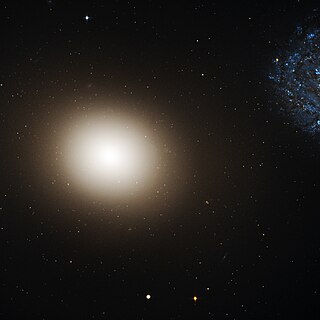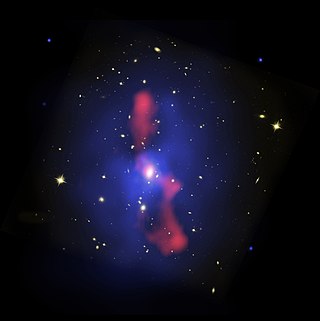
Messier 87 is a supergiant elliptical galaxy in the constellation Virgo that contains several trillion stars. One of the largest and most massive galaxies in the local universe, it has a large population of globular clusters—about 15,000 compared with the 150–200 orbiting the Milky Way—and a jet of energetic plasma that originates at the core and extends at least 1,500 parsecs, traveling at a relativistic speed. It is one of the brightest radio sources in the sky and a popular target for both amateur and professional astronomers.

A supermassive black hole is the largest type of black hole, with its mass being on the order of hundreds of thousands, or millions to billions of times the mass of the Sun (M☉). Black holes are a class of astronomical objects that have undergone gravitational collapse, leaving behind spheroidal regions of space from which nothing can escape, not even light. Observational evidence indicates that almost every large galaxy has a supermassive black hole at its center. For example, the Milky Way galaxy has a supermassive black hole at its center, corresponding to the radio source Sagittarius A*. Accretion of interstellar gas onto supermassive black holes is the process responsible for powering active galactic nuclei (AGNs) and quasars.

The Chandra X-ray Observatory (CXO), previously known as the Advanced X-ray Astrophysics Facility (AXAF), is a Flagship-class space telescope launched aboard the Space ShuttleColumbia during STS-93 by NASA on July 23, 1999. Chandra is sensitive to X-ray sources 100 times fainter than any previous X-ray telescope, enabled by the high angular resolution of its mirrors. Since the Earth's atmosphere absorbs the vast majority of X-rays, they are not detectable from Earth-based telescopes; therefore space-based telescopes are required to make these observations. Chandra is an Earth satellite in a 64-hour orbit, and its mission is ongoing as of 2023.

An intermediate-mass black hole (IMBH) is a class of black hole with mass in the range 102–105 solar masses: significantly more than stellar black holes but less than the 105–109 solar mass supermassive black holes. Several IMBH candidate objects have been discovered in the Milky Way galaxy and others nearby, based on indirect gas cloud velocity and accretion disk spectra observations of various evidentiary strength.

The Sombrero Galaxy is a peculiar galaxy of unclear classification in the constellation borders of Virgo and Corvus, being about 9.55 megaparsecs from the Milky Way galaxy. It is a member of the Virgo II Groups, a series of galaxies and galaxy clusters strung out from the southern edge of the Virgo Supercluster. It has an isophotal diameter of approximately 29.09 to 32.32 kiloparsecs, making it slightly bigger in size than the Milky Way.

Messier 60 or M60, also known as NGC 4649, is an elliptical galaxy approximately 57 million light-years away in the equatorial constellation of Virgo. Together with NGC 4647, it forms a pair known as Arp 116. Messier 60 and nearby elliptical galaxy Messier 59 were discovered by Johann Gottfried Koehler in April 1779, observing a comet in the same part of the sky. Charles Messier added both to his catalogue about three days after this.

A dwarf galaxy is a small galaxy composed of about 1000 up to several billion stars, as compared to the Milky Way's 200–400 billion stars. The Large Magellanic Cloud, which closely orbits the Milky Way and contains over 30 billion stars, is sometimes classified as a dwarf galaxy; others consider it a full-fledged galaxy. Dwarf galaxies' formation and activity are thought to be heavily influenced by interactions with larger galaxies. Astronomers identify numerous types of dwarf galaxies, based on their shape and composition.

NGC 3115 is a field lenticular (S0) galaxy in the constellation Sextans. The galaxy was discovered by William Herschel on February 22, 1787. At about 32 million light-years away from Earth, it is several times bigger than the Milky Way. It is a lenticular (S0) galaxy because it contains a disk and a central bulge of stars, but without a detectable spiral pattern. NGC 3115 is seen almost exactly edge-on, but was nevertheless mis-classified as elliptical. There is some speculation that NGC 3115, in its youth, was a quasar.

NGC 4395 is a nearby low surface brightness spiral galaxy located about 14 million light-years from Earth in the constellation Canes Venatici. The nucleus of NGC 4395 is active and the galaxy is classified as a Seyfert Type I known for its very low-mass supermassive black hole.

NGC 1300 is a barred spiral galaxy located about 61 million light-years away in the constellation Eridanus. The galaxy is about 110,000 light-years across. It is a member of the Eridanus Cluster, a cluster of 200 galaxies. It was discovered by John Herschel in 1835.

NGC 5548 is a Type I Seyfert galaxy with a bright, active nucleus. This activity is caused by matter flowing onto a 65 million solar mass (M☉) supermassive black hole at the core. Morphologically, this is an unbarred lenticular galaxy with tightly-wound spiral arms, while shell and tidal tail features suggest that it has undergone a cosmologically-recent merger or interaction event. NGC 5548 is approximately 245 million light years away and appears in the constellation Boötes. The apparent visual magnitude of NGC 5548 is approximately 13.3 in the V band.

MS 0735.6+7421 is a galaxy cluster located in the constellation Camelopardalis, approximately 2.6 billion light-years away. It is notable as the location of one of the largest central galactic black holes in the known universe, which has also apparently produced one of the most powerful active galactic nucleus eruptions discovered.
Stellar mass is a phrase that is used by astronomers to describe the mass of a star. It is usually enumerated in terms of the Sun's mass as a proportion of a solar mass (M☉). Hence, the bright star Sirius has around 2.02 M☉. A star's mass will vary over its lifetime as mass is lost with the stellar wind or ejected via pulsational behavior, or if additional mass is accreted, such as from a companion star.

The Phoenix Cluster is a massive, Abell class type I galaxy cluster located at its namesake, southern constellation of Phoenix. It was initially detected in 2010 during a 2,500 square degree survey of the southern sky using the Sunyaev–Zeldovich effect by the South Pole Telescope collaboration. It is one of the most massive galaxy clusters known, with the mass on the order of 2×1015M☉, and is the most luminous X-ray cluster discovered, producing more X-rays than any other known massive cluster. It is located at a comoving distance of 8.612 billion light-years from Earth. About 42 member galaxies were identified and currently listed in the SIMBAD Astronomical Database, though the real number may be as high as 1,000.

NGC 1277 is a lenticular galaxy in the constellation of Perseus. It is a member of the Perseus Cluster of galaxies and is located approximately 73 Mpc (megaparsecs) or 220 million light-years from the Milky Way. It has an apparent magnitude of about 14.7. It was discovered on December 4, 1875 by Lawrence Parsons, 4th Earl of Rosse.

M59-UCD3 is an ultra-compact dwarf galaxy located near the Messier 59 galaxy. As of 2015, it is the second-densest galaxy currently observed, second to M85-HCC1.

M85-HCC1 is an ultracompact dwarf galaxy with a star density 1,000,000 times that of the solar neighbourhood, lying near the galaxy Messier 85. As of 2015, it is the densest galaxy known.

ESO 444-46 is a class E4 supergiant elliptical galaxy; the dominant and brightest member of the Abell 3558 galaxy cluster around 640 million light-years away in the constellation Centaurus. It lies within the core of the massive Shapley Supercluster, one of the closest neighboring superclusters. It is one of the largest galaxies in the local universe, and possibly contains one of the most massive black holes known. The black hole's mass is very uncertain, with estimates ranging from as low as 501 million M☉, to as high as 77.6 billion M☉.

NGC 541 is a lenticular galaxy located in the constellation Cetus. It is located at a distance of circa 230 million light years from Earth, which, given its apparent dimensions, means that NGC 541 is about 130,000 light years across. It was discovered by Heinrich d'Arrest on October 30, 1864. It is a member of the Abell 194 galaxy cluster and is included in the Atlas of Peculiar Galaxies in the category galaxies with nearby fragments. NGC 541 is a radio galaxy of Fanaroff-Riley class I, also known as 3C 40A.





















